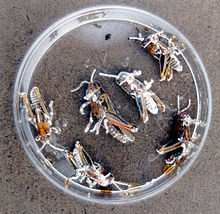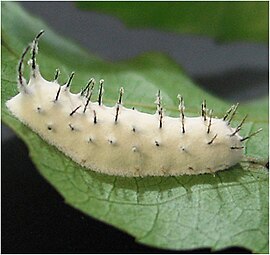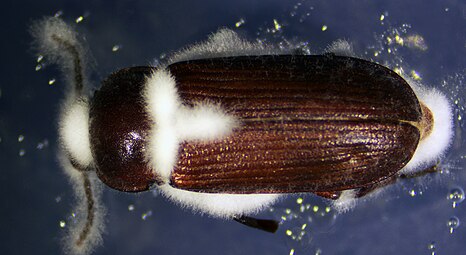Beauveria bassiana is a fungus that grows naturally in soils throughout the world and acts as a parasite on various arthropod species, causing white muscardine disease; it thus belongs to the group of entomopathogenic fungi. It is used as a biological insecticide to control a number of pests, including termites, thrips, whiteflies, aphids and various beetles. Its use in the control of bed bugs[1] and malaria-transmitting mosquitos is under investigation.[2]
| Beauveria bassiana | |
|---|---|
 | |
| Grasshoppers killed by B. bassiana | |
| Scientific classification | |
| Domain: | Eukaryota |
| Kingdom: | Fungi |
| Division: | Ascomycota |
| Class: | Sordariomycetes |
| Order: | Hypocreales |
| Family: | Cordycipitaceae |
| Genus: | Beauveria |
| Species: | B. bassiana |
| Binomial name | |
| Beauveria bassiana (Bals.-Criv.) Vuill. (1912) | |
| Synonyms | |
| |
Taxonomy
The species is named after the Italian entomologist Agostino Bassi, who discovered it in 1835 in silkworms (Bombyx mori).[3] Bassi performed the first infection experiments, and determined the fungus to be the cause of the muscardine disease, which then led to carriers transmitting it by airborne means. Later the same year, the fungus was named Botrytis bassiana by Giuseppe Gabriel Balsamo-Crivelli.[3] The species epithet honours Bassi, the discoverer:[3]
In 1911 Jean Beauverie did further study and the next year Jean Paul Vuillemin made it the type species of his new genus, Beauveria, a name which honors Beauverie.[4][3]
The name B. bassiana has long been used to describe a species complex of morphologically similar and closely related isolates. Rehner and Buckley[5] have shown that B. bassiana consists of many distinct lineages that should be recognized as distinct phylogenetic species and the genus Beauveria was redescribed with a proposed type for B. bassiana in 2011.[6]
The species was formerly also known as Tritirachium shiotae, among other synonyms.
Relation to Cordyceps and other fungi
Beauveria bassiana is the anamorph (asexually reproducing form) of Cordyceps bassiana. The latter teleomorph (the sexually reproducing form) has been collected only in eastern Asia.[7]
Description
B. bassiana is a white mould when grown on culture, producing white spore balls made up of many conidia that are single-celled, haploid, and hydrophobic.[8][9] The short, ovoid conidiogenous cells that produce the conidia have a narrow apical extension called a rachis, which elongates into a long zig-zag extension.[10][9]
Ecology

The insect disease caused by the fungus is a muscardine which has been called white muscardine disease. When the microscopic spores of the fungus come into contact with the body of an insect host, they germinate, penetrate the cuticle, and grow inside, killing the insect within a matter of days. Afterwards, a white mold emerges from the cadaver and produces new spores. A typical isolate of B. bassiana can attack a broad range of insects; various isolates differ in their host range.
Beauveria bassiana parasitizing the Colorado potato beetle has been reported to be, in turn, the host of a mycoparasitic fungus Syspastospora parasitica.[11] This organism also attacks related insect-pathogenic species of the Clavicipitaceae.
A fungus attributed to be B. bassiana was observed to cause infections in a captive American alligator[12] and B. bassiana was implicated in causing a pulmonary disease in captive tortoises.[13][14] The reptiles were in captivity and under temperature stress which may explain their susceptibility to the fungus. When a tortoise was kept at 22 °C and injected with 0.5 mL of 106 spores of B. bassiana into the lung, no mortality was observed, while a second contaminated tortoise died when kept only at 16 °C.[15]
A microevolutionary experiment in 2013 showed that the Greater wax moth (Galleria mellonella) was able to adapt its defense mechanisms during 25 generations, while being under constant selective pressure from B. bassiana. The moth developed resistance, but apparently, at a cost.[16]
Wagner and Lewis reported the ability of B. bassiana to grow as an endophyte in corn.[17]
Toxicity
The fungus rarely infects humans or other animals, so it is generally considered safe as an insecticide. However, at least one case of human infection by B. bassiana has been reported in a person with a suppressed immune system.[18] Additionally, the spores may exacerbate breathing difficulties.
Uses
Beauveria bassiana can be used as a biological insecticide to control a number of pests such as termites, whiteflies, and many other insects. Its use in the control of malaria-transmitting mosquitos is under investigation.[2] As an insecticide, the spores are sprayed on affected crops as an emulsified suspension or wettable powder or applied to mosquito nets as a mosquito control agent.
As a species, B. bassiana parasitizes a very wide range of arthropod hosts. However, different strains vary in their host ranges, some having rather narrow ranges, like strain Bba 5653 that is very virulent to the larvae of the diamondback moth and kills only few other types of caterpillars. Some strains do have a wide host range and should, therefore, be considered nonselective biological insecticides. These should not be applied to flowers visited by pollinating insects.[19] Known targets of the species include:[20][21][22]
- Aphids
- Whiteflies
- Mealybugs
- Psyllids
- Chinch bug
- Lygus bugs
- Grasshoppers
- Stink bugs (Halyomorpha halys)[23]
- Thrips
- Termites
- Fire ants
- Flies
- Stem borers
- Fungal gnats
- Shoreflies
- Beetles
- Caterpillars
- Mites
Preliminary research has shown the fungus is 100% effective in eliminating bed bugs exposed to cotton fabric sprayed with fungus spores. It is also effective against bed bug colonies due to B. bassiana carried by infected bugs back to their harborages. The tested strain of B. bassiana caused rapid mortality (3–5 days) after short-term exposure.[1] In a 2017 follow-up study, pyrethroid-resistant bed bugs had >94% mortality after treatment with a commercial preparation of B. bassiana.[28]
Containment leak
In March 2013, genetically modified B. bassiana was found in a number of research laboratories and greenhouses outside of a designated containment area at Lincoln University in Christchurch, New Zealand. The Ministry for Primary Industries investigated the leak.[29]
Gallery
See also
- Biological insecticides
- Metarhizium spp. which cause "green muscardine" disease
References
Further reading
- Luz C, Rocha LF, Nery GV, Magalhães BP, Tigano MS (March 2004). "Activity of oil-formulated Beauveria bassiana against Triatoma sordida in peridomestic areas in Central Brazil". Mem. Inst. Oswaldo Cruz. 99 (2): 211–8. doi:10.1590/S0074-02762004000200017. hdl:1807/2301. PMID 15250478.
- Prior C, Jollands P, Le Patourel G (1988). "Infectivity of oil and water formulations of Beauveria bassiana (Deuteromycotina; Hyphomycetes) to the cocoa weevil pest Pantorhytes plutus (Coleoptera: Curculionidae)". Journal of Invertebrate Pathology. 52 (1): 66–72. doi:10.1016/0022-2011(88)90103-6.
External links
 Media related to Beauveria bassiana at Wikimedia Commons
Media related to Beauveria bassiana at Wikimedia Commons- Beauveria bassiana discussed on RNZ Critter of the Week, 1 September 2023






